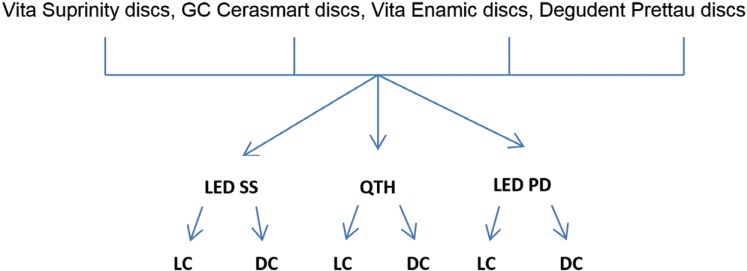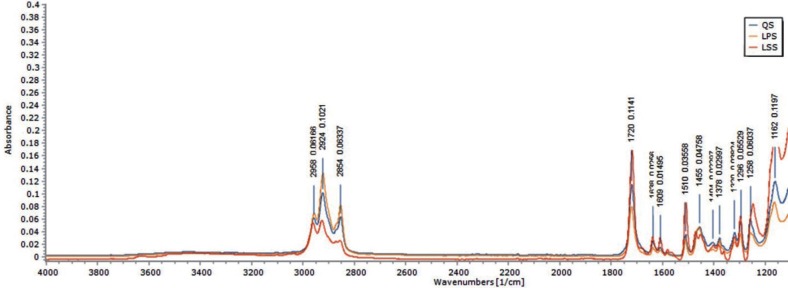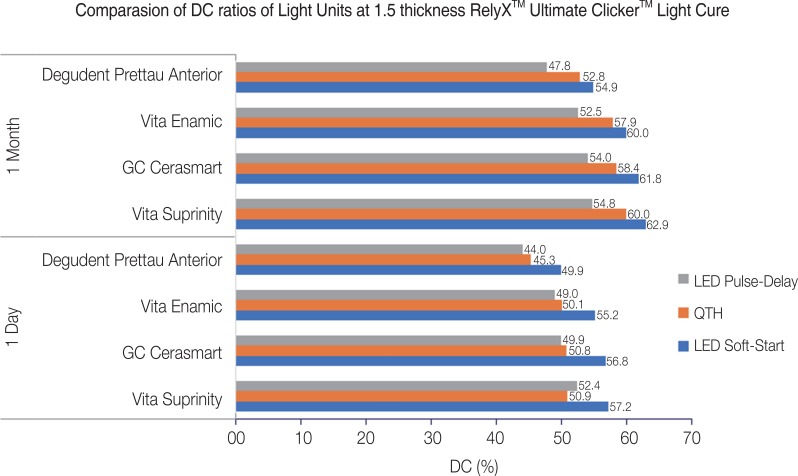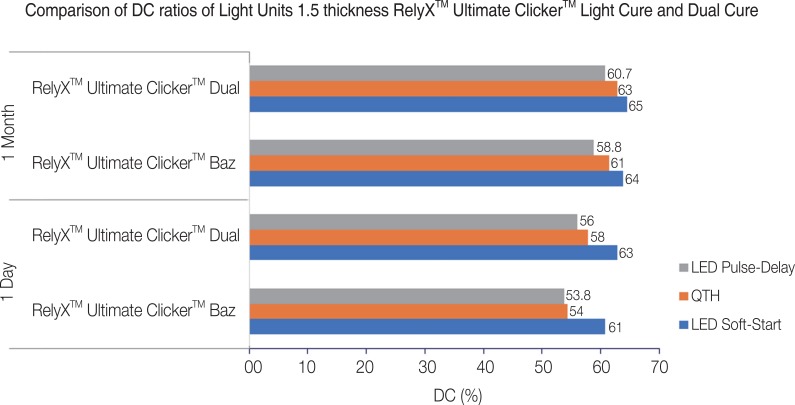J Adv Prosthodont.
2018 Aug;10(4):291-299. 10.4047/jap.2018.10.4.291.
The effect of light sources and CAD/CAM monolithic blocks on degree of conversion of cement
- Affiliations
-
- 1Bağcılar Educational and Research Hospital, Istanbul, Turkey.
- 2Department of Prosthodontics, Faculty of Dentistry, Istanbul University, Istanbul, Turkey. degerkongul@yahoo.com
- KMID: 2418635
- DOI: http://doi.org/10.4047/jap.2018.10.4.291
Abstract
- PURPOSE
To assess the degree of conversion (DC) and light irradiance delivered to light-cured and dual-cured cements by application of different light sources through various types of monolithic computer-aided design and computer-aided manufacturing (CAD/CAM) materials.
MATERIALS AND METHODS
RelyX Ultimate Clicker light-cured and dual-cured resin cement specimens with 1.5-mm thicknesses (n=300, 10/group), were placed under four types of crystalline core structure (Vita Enamic, Vita Suprinity, GC Ceresmart, Degudent Prettau Anterior). The specimens were irradiated for 40 seconds with an LED Soft-Start or pulse-delay unit or 20 seconds with a QTH unit. DC ratios were determined by using Fourier transform infrared spectroscopy (FTIR) after curing the specimen at 1 day and 1 month. The data were analyzed using the Mann-Whitney U test (for paired comparison) and the Kruskal-Wallis H test (for multiple comparison), with a significance level of P < .05.
RESULTS
DC values were the highest for RelyX Ultimate Clicker light-cure specimens polymerized with the LED Soft-Start unit. The combination of the Vita Suprinity disc and RelyX Ultimate Clicker dual-cure resin cement yielded significantly higher values at both timepoints with all light units (all, P < .05).
CONCLUSION
Within the limitations of this study, we conclude that the DC of RelyX Ultimate Clicker dual-cure resin cement was improved significantly by the use of Vita Suprinity and the LED Soft-Start light unit. We strongly recommend the combined use of an LED light unit and dual-cure luting cement for monolithic ceramic restorations.
Keyword
MeSH Terms
Figure
Reference
-
1. Lee IB, An W, Chang J, Um CM. Influence of ceramic thickness and curing mode on the polymerization shrinkage kinetics of dual-cured resin cements. Dent Mater. 2008; 24:1141–1147. PMID: 18433858.
Article2. Archegas LR, Freire A, Vieira S, Caldas DB, Souza EM. Colour stability and opacity of resin cements and flowable composites for ceramic veneer luting after accelerated ageing. J Dent. 2011; 39:804–810. PMID: 21911032.
Article3. Kumbuloglu O, Lassila LV, User A, Vallittu PK. A study of the physical and chemical properties of four resin composite luting cements. Int J Prosthodont. 2004; 17:357–363. PMID: 15237886.4. Kelly JR, Benetti P. Ceramic materials in dentistry: historical evolution and current practice. Aust Dent J. 2011; 56:84–96. PMID: 21564119.
Article5. Flury S, Lussi A, Hickel R, Ilie N. Light curing through glass ceramics: effect of curing mode on micromechanical properties of dual-curing resin cements. Clin Oral Investig. 2014; 18:809–818.
Article6. Nakamura K, Harada A, Inagaki R, Kanno T, Niwano Y, Milleding P, Örtengren U. Fracture resistance of monolithic zirconia molar crowns with reduced thickness. Acta Odontol Scand. 2015; 73:602–608. PMID: 25635734.
Article7. Pelaez J, Cogolludo PG, Serrano B, Serrano JF, Suarez MJ. A four-year prospective clinical evaluation of zirconia and metal-ceramic posterior fixed dental prostheses. Int J Prosthodont. 2012; 25:451–458. PMID: 22930766.8. Halvorson RH, Erickson RL, Davidson CL. Energy dependent polymerization of resin-based composite. Dent Mater. 2002; 18:463–469. PMID: 12098575.
Article9. Rueggeberg FA, Caughman WF, Curtis JW Jr, Davis HC. A predictive model for the polymerization of photo-activated resin composites. Int J Prosthodont. 1994; 7:159–166. PMID: 8003197.10. Yan YL, Kim YK, Kim KH, Kwon TY. Changes in degree of conversion and microhardness of dental resin cements. Oper Dent. 2010; 35:203–210. PMID: 20420064.
Article11. Arrais CA, Giannini M, Rueggeberg FA. Kinetic analysis of monomer conversion in auto- and dual-polymerizing modes of commercial resin luting cements. J Prosthet Dent. 2009; 101:128–136. PMID: 19167537.
Article12. Burke FJ. Trends in indirect dentistry: 3. Luting materials. Dent Update. 2005; 32:251–254. 257–258. 260PMID: 15977720.
Article13. Moraes RR, Brandt WC, Naves LZ, Correr-Sobrinho L, Piva E. Light- and time-dependent polymerization of dual-cured resin luting agent beneath ceramic. Acta Odontol Scand. 2008; 66:257–261. PMID: 18618339.
Article14. Ernst CP, Cohnen U, Stender E, Willershausen B. In vitro retentive strength of zirconium oxide ceramic crowns using different luting agents. J Prosthet Dent. 2005; 93:551–558. PMID: 15942616.
Article15. Asmussen E, Peutzfeldt A. Polymer structure of a light-cured resin composite in relation to distance from the surface. Eur J Oral Sci. 2003; 111:277–279. PMID: 12786961.
Article16. Asmussen E, Peutzfeldt A. Influence of pulse-delay curing on softening of polymer structures. J Dent Res. 2001; 80:1570–1573. PMID: 11499515.
Article17. Chan KC, Boyer DB. Curing light-activated composite cement through porcelain. J Dent Res. 1989; 68:476–480. PMID: 2921390.
Article18. Davidson CL, Mjor IA. Physical properties of glass ionomer cements: setting shirinkage and wear. Advances in Glass Ionomer Cements. Quintessence Publishing Co. Inc.;1999. p. 51–65.19. Arrais CA, Giannini M, Rueggeberg FA, Pashley DH. Microtensile bond strength of dual-polymerizing cementing systems to dentin using different polymerizing modes. J Prosthet Dent. 2007; 97:99–106. PMID: 17341378.
Article20. Asmussen E, Peutzfeldt A. Polymerization contraction of resin composite vs. energy and power density of light-cure. Eur J Oral Sci. 2005; 113:417–421. PMID: 16202030.
Article21. Moraes LG, Rocha RS, Menegazzo LM, de Araújo EB, Yukimito K, Moraes JC. Infrared spectroscopy: a tool for determination of the degree of conversion in dental composites. J Appl Oral Sci. 2008; 16:145–149. PMID: 19089207.
Article22. Moraes RR, Boscato N, Jardim PS, Schneider LF. Dual and self-curing potential of self-adhesive resin cements as thin films. Oper Dent. 2011; 36:635–642. PMID: 21864125.
Article23. Souza EJ Jr, Borges BC, Oliveira DC, Brandt WC, Hirata R, Silva EJ, Sinhoreti MA. Influence of the curing mode on the degree of conversion of a dual-cured self-adhesive resin luting cement beneath ceramic. Acta Odontol Scand. 2013; 71:444–448. PMID: 22630602.24. Tarle Z, Meniga A, Knezević A, Sutalo J, Ristić M, Pichler G. Composite conversion and temperature rise using a conventional, plasma arc, and an experimental blue LED curing unit. J Oral Rehabil. 2002; 29:662–667. PMID: 12153456.
Article25. Bala O, Olmez A, Kalayci S. Effect of LED and halogen light curing on polymerization of resin-based composites. J Oral Rehabil. 2005; 32:134–140. PMID: 15641980.
Article26. Sulaiman TA, Abdulmajeed AA, Donovan TE, Ritter AV, Lassila LV, Vallittu PK, Närhi TO. Degree of conversion of dual-polymerizing cements light polymerized through monolithic zirconia of different thicknesses and types. J Prosthet Dent. 2015; 114:103–108. PMID: 25882969.
Article27. Sen N, Us YO. Mechanical and optical properties of monolithic CAD-CAM restorative materials. J Prosthet Dent. 2018; 119:593–599. PMID: 28781072.
Article28. Acar O, Yilmaz B, Altintas SH, Chandrasekaran I, Johnston WM. Color stainability of CAD/CAM and nanocomposite resin materials. J Prosthet Dent. 2016; 115:71–75. PMID: 26386483.
Article29. van Noort R. Introduction to dental materials. 4th ed. Elsevier Inc.;Mosby Ltd.;2013. p. 231–232.
- Full Text Links
- Actions
-
Cited
- CITED
-
- Close
- Share
- Similar articles
-
- Maxillary cement retained implant supported monolithic zirconia prosthesis in a full mouth rehabilitation: a clinical report
- The effect of thickness and translucency of polymer-infiltrated ceramic-network material on degree of conversion of resin cements
- Fabrication of maxillary complete denture and mandibular implant retained overdenture using CAD-CAM system and Monolithic disc: a case report
- Fabrication of complete denture using conventional method and monolithic digital denture system: a case report
- Fabrication of complete dentures made with monolithic discs through CAD/CAM using facial scan data and individual tray duplicating temporary denture: a case report







